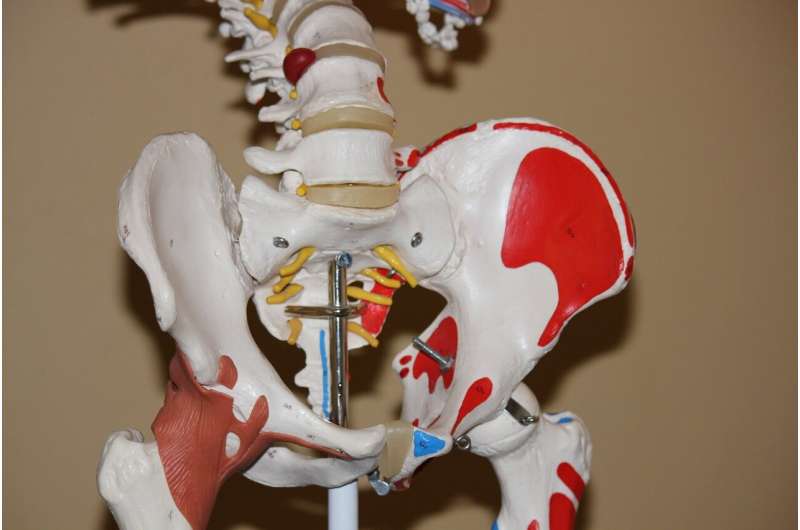This article has been reviewed according to Science X's editorial process and policies. Editors have highlighted the following attributes while ensuring the content's credibility:
fact-checked
trusted source
proofread
Why don't more patients receive quality standard of care for hip fractures?

Hip fractures are a common and painful occurrence in Canada, with data showing roughly 30,000 patients present with hip fractures a year, and more than 30% of those patients are over the age of 85. Opioids are effective at relieving acute pain, but older patients often have increased sensitivity to their side effects.
An anesthetic technique called Fascia Iliaca Compartment Nerve Block (FICB) is a safe and cost-effective way to reduce pain for hip fractures in older adults that is performed by anesthesiologists and trained emergency physicians at St. Michael's. Despite FICB being a Health Quality Ontario quality standard, it is not commonly performed in the province, with data showing the overall rate of FICB use in Ontario at approximately 15%.
A new study led by St. Michael's Hospital researchers investigated why so few patients receive FICB. After identifying several barriers and facilitators to administering FICB, the researchers implemented strategies to overcome those barriers, resulting in a 17% increase in FICB uptake at St. Michael's (from 48% to 65%). The work is published in the Canadian Journal of Anesthesia/Journal canadien d'anesthésie.
"FICB is the health quality standard that health care organizations should meet. The benefits of FICB are well known, such as preventing adverse events associated with opioids, reduction of pain at rest and with movement most often within 30 minutes, reduced pneumonia, faster time to mobility and shorter hospital stays," said Marjorie Hammond, clinical nurse specialist and study lead author.
"We wanted to know how our hospital can perform this procedure more frequently, efficiently and in a time sensitive way. Our goal is delivery of the procedure within 12 hours of hip fracture diagnosis. Additionally we wanted to demonstrate effective collaboration between the emergency, anesthesia, orthopedics, and geriatrics departments at St. Michael's."
Identifying the barriers, finding facilitators
To identify barriers, Hammond and her research team conducted 30 staff interviews and five patient-caregiver interviews in 2019 and 2020. The team also conducted three site observation visits in 2019 at St. Michael's in orthopedics, anesthesia, and the emergency department.
Based off those interviews, the team identified 18 barriers to implementing FICB, including issues surrounding hospital staff skills, a general lack of clinician knowledge of FICB, and a lack of communication between departments. There were also barriers related to patient concerns about adverse effects and patients having difficulty making decisions while in pain.
The research team also identified 11 facilitators to implementing FICB. These included improving access to information about the procedure, increasing patient education, as well as identifying "change champions"—staff who could help promote the procedure among peers and colleagues.
Based on scientific mapping of facilitators to implementation strategies, eight strategies were selected with the goal of increasing FICB uptake.
Particular attention was placed on restructuring the clinical environment, which included developing a standard process within the hip fracture care pathway, adding the FICB intervention to the hip fracture admission order set, and organizing a dedicated team with new physical space in the anesthesia regional room to administer FICB. Educational materials were developed and tailored to interprofessional staff, patients and caregivers. Additionally tools were developed for clinical processes, roles and responsibilities of the nursing team.
Uptake rate of FICB in eligible patients over the age of 65 rose from 48% (March 2017 to February 2018) to 65% (March 2021 to February 2022). The time to FICB decreased from 1.52 days to 0.86 during the same time period.
"The study findings brought improved care and pain relief to more patients at St. Michael's," said Hammond.
"This interprofessional practice based research team utilized implementation science methods to improve the use of FICB at St. Michael's. Our study has proven that taking a scientific approach to the implementation of best practices does improve quality of care for hip fracture patients. This is knowledge translation."
More information: Marjorie Hammond et al, Using implementation science to promote the use of the fascia iliaca blocks in hip fracture care, Canadian Journal of Anesthesia/Journal canadien d'anesthésie (2023). DOI: 10.1007/s12630-023-02665-2





















